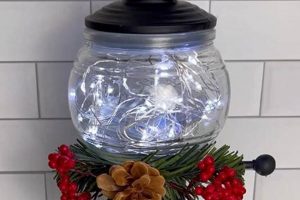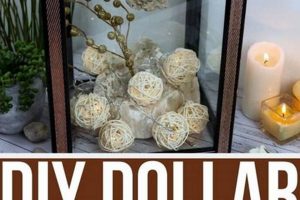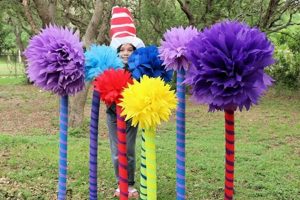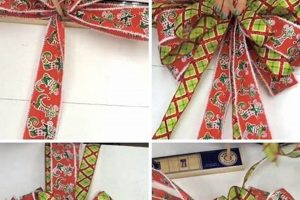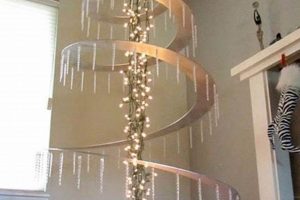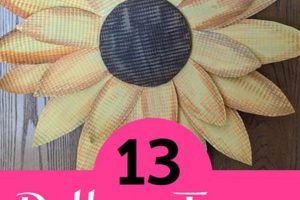Protective cylinders constructed from readily available materials designed to shield young saplings from various environmental threats and animal predation. These structures, often fabricated from items like plastic netting, cardboard, or repurposed materials, provide a microclimate conducive to accelerated growth and increased survival rates for newly planted trees. For instance, a grower might fashion these protective barriers from PVC pipe and mesh to safeguard vulnerable seedlings in exposed locations.
The implementation of such protective measures offers considerable advantages, including enhanced growth rates, reduced mortality among saplings, and decreased reliance on chemical deterrents. Historically, the practice of shielding young trees has evolved from simple fencing to sophisticated, engineered solutions. These custom-built shelters contribute significantly to reforestation efforts, habitat restoration projects, and the establishment of sustainable agroforestry systems. The practice supports ecological balance and long-term environmental resilience.
The subsequent sections will explore the specific materials and methods employed in their construction, examine the diverse range of designs adaptable to various tree species and environmental conditions, and provide guidance on effective installation and maintenance practices. Furthermore, it will consider the economic and ecological implications of utilizing these resourceful approaches to tree cultivation.
Construction Advice for Sapling Protectors
The following recommendations aim to optimize the construction and deployment of protective structures for young trees, thereby maximizing their effectiveness and longevity.
Tip 1: Material Selection: Prioritize durable and weather-resistant materials. UV-stabilized plastic netting, corrugated plastic, or treated cardboard offer enhanced protection against degradation from sunlight and moisture. Consider locally sourced, recycled materials to reduce environmental impact and project costs.
Tip 2: Proper Height Determination: The height of the structure should sufficiently shield the terminal bud of the sapling from browsing animals, typically deer or rabbits. A height of 3-4 feet is generally adequate, but adjustments may be necessary depending on local wildlife pressure.
Tip 3: Adequate Ventilation: Ensure sufficient airflow within the structure to prevent the buildup of excessive heat and humidity, which can promote fungal diseases. Perforations or strategic gaps in the material can facilitate ventilation without compromising protection.
Tip 4: Secure Anchoring: Properly anchor the structure to prevent displacement by wind or animal activity. Sturdy stakes, rebar, or metal T-posts driven deeply into the ground provide reliable support. Consider using biodegradable stakes for temporary installations.
Tip 5: Regular Monitoring and Maintenance: Periodically inspect the structures for damage, debris accumulation, or signs of plant disease. Promptly repair any damage and remove any accumulated debris to maintain optimal growing conditions.
Tip 6: Diameter Considerations: Ensure that the diameter of the structure is large enough to accommodate the sapling’s growth for at least one to two growing seasons. Avoid constriction, which can hinder trunk development and increase susceptibility to disease.
By adhering to these guidelines, the effectiveness and lifespan of the sapling protection structures are increased, leading to enhanced tree survival and overall forest health.
The subsequent section will delve into specific design considerations for various tree species and site conditions.
1. Material Durability
Material durability is a critical factor determining the long-term efficacy of protective structures for saplings. The selection of materials directly impacts the structural integrity and lifespan of these shelters, influencing their ability to withstand environmental stressors such as ultraviolet radiation, fluctuating temperatures, precipitation, and physical damage from wildlife. Substandard materials degrade prematurely, compromising the intended protection and potentially necessitating costly replacements. The failure to account for material durability undermines the initial investment in tree planting and protective measures.
Consider the example of a reforestation project utilizing cardboard for tube construction. While cost-effective and biodegradable, untreated cardboard rapidly deteriorates under wet conditions, collapsing and offering negligible protection within a single growing season. Conversely, using UV-stabilized polypropylene netting, despite a higher initial cost, provides several years of robust protection, significantly increasing sapling survival rates. The increased lifespan translates into lower overall costs, as the reduced need for replacement and maintenance offsets the initial expense. The trade-off between upfront cost and long-term performance is a crucial consideration.
The consideration of material durability is inextricably linked to the overall success of these sapling protectors. The long-term performance of planted trees depends on the protective measures remaining effective. Factors such as localized climate, prevalent wildlife, and tree growth rate should inform material selection. Overlooking these factors results in diminished project outcomes.
2. Appropriate Height
The dimension of height directly influences the effectiveness of DIY tree tubes in safeguarding young saplings. Insufficient height fails to protect the terminal bud, rendering the tube ineffective against browsing animals such as deer and rabbits. Conversely, excessive height may increase material costs and susceptibility to wind damage without providing commensurate benefits. The selection of a suitable height requires careful consideration of local wildlife pressures, the typical growth rate of the targeted tree species, and site-specific environmental conditions.
In regions with high deer populations, for instance, a tube height of at least four feet is often necessary to prevent browsing damage. Smaller rodents, such as voles, may necessitate the use of protective mesh at the base of the tube, regardless of overall height. The growth habit of the tree species also plays a vital role. Fast-growing species require taller tubes to accommodate their rapid vertical development. Moreover, exposed sites with high wind speeds necessitate shorter, sturdier designs to minimize the risk of toppling, potentially sacrificing some browsing protection. Therefore, height should be considered as a strategic compromise between these competing factors.
Determining the optimal height necessitates a comprehensive understanding of local ecological dynamics and the specific requirements of the tree species being protected. A failure to adequately address this factor compromises the overall efficacy of such devices, leading to increased mortality rates and reduced reforestation success. The height decision remains paramount in maximizing the return on investment in tree planting efforts.
3. Adequate Ventilation
The provision of adequate ventilation within a sapling protection structure, or tree tube, constitutes a critical element in its overall functionality and effectiveness. The enclosed environment created by a tree tube, while offering protection from physical damage and herbivory, also presents a potential for detrimental microclimatic conditions. Without sufficient airflow, heat and humidity can accumulate, fostering fungal diseases and hindering the healthy development of the seedling. The absence of proper ventilation can negate the intended benefits of the tube, potentially leading to increased mortality rates. For instance, a tree tube constructed of solid, impermeable material in a humid environment may create a breeding ground for pathogens, ultimately harming the very plant it is designed to protect.
Effective ventilation can be achieved through various design modifications. Perforations or mesh sections incorporated into the tube structure facilitate air exchange, preventing the build-up of excessive moisture and regulating temperature. The size and placement of these ventilation features must be carefully calibrated to balance the need for airflow with the requirement for protection. Too few or too small openings may prove insufficient, while excessively large openings compromise the tube’s primary function of shielding the sapling from animal browsing or wind damage. Real-world examples demonstrate the efficacy of this approach; tree tubes with strategically placed ventilation slits have exhibited significantly lower incidences of fungal infections and improved sapling vigor compared to non-ventilated counterparts.
In conclusion, adequate ventilation represents a non-negotiable aspect of sapling protection design. It is not merely an ancillary feature, but an essential component that directly influences the health and survival of the tree. A thorough understanding of the interplay between ventilation, microclimate, and plant physiology is crucial for successful implementation of sapling protectors, ensuring that these structures contribute positively to reforestation and afforestation efforts. Challenges in achieving optimal ventilation often arise from balancing protective functions with aeration needs, underscoring the importance of carefully considering environmental context and species-specific requirements in the development and deployment of such devices.
4. Secure Anchoring
Secure anchoring is a fundamental requirement for the successful deployment of DIY tree tubes. Without adequate stabilization, these protective structures are vulnerable to displacement by wind, animal activity, or soil erosion, negating their intended benefits and potentially causing damage to the sapling.
- Stake Selection and Placement
The choice of stake material (wood, metal, plastic) and its placement relative to the tree tube directly influences the structure’s stability. Stakes must be of sufficient length and strength to resist bending or breaking under pressure. Strategically positioning multiple stakes around the perimeter of the tube, driven deeply into the ground, provides enhanced resistance to lateral forces. Improper stake selection or placement compromises the anchoring system, increasing the risk of tube displacement.
- Soil Type and Anchoring Depth
Soil composition significantly affects the holding power of anchoring systems. Loose, sandy soils require deeper stake penetration or the use of wider stakes to achieve adequate stability. Rocky soils may necessitate alternative anchoring methods, such as the use of ground screws or rock anchors. Failure to account for soil type leads to inadequate anchoring, increasing the likelihood of the tube becoming dislodged.
- Wind Load Considerations
Sites exposed to high winds require more robust anchoring systems. Taller tree tubes are particularly susceptible to wind loading. In such environments, consider using multiple stakes, guy wires, or heavier-duty anchoring materials. Failure to adequately address wind loads results in tube collapse or displacement, leaving the sapling vulnerable.
- Animal Disturbance Prevention
Certain animals may attempt to topple or dislodge tree tubes, particularly if they are not securely anchored. The addition of wire mesh aprons around the base of the tube or the use of deterrents can help prevent animal disturbance. Secure anchoring, in combination with these measures, provides comprehensive protection against both environmental forces and animal interference.
The effectiveness of DIY tree tubes is directly contingent upon the robustness of their anchoring. A well-anchored tube remains in place, providing consistent protection to the sapling throughout its critical early growth stages. Compromised anchoring undermines the entire protection strategy, potentially leading to project failure.
5. Diameter allowance
Diameter allowance, as it pertains to homemade sapling protectors, signifies the space afforded within the tube to accommodate the trunk’s expanding girth over time. Insufficient allowance results in constriction, impeding the natural growth process and creating physical stress on the developing stem. This, in turn, can increase susceptibility to disease and insect infestation. Real-world examples show that trees confined within tightly fitted structures exhibit stunted growth, girdling, and, in severe cases, mortality. Therefore, understanding and implementing an appropriate diameter allowance becomes a crucial component in the effective deployment of these protective measures.
The practical application of diameter allowance involves careful planning during the construction phase. The initial diameter of the DIY tree tube should be calculated based on the expected growth rate of the tree species and the anticipated duration of protection. Faster-growing species necessitate larger initial diameters or designs that allow for expansion. Techniques such as using larger diameter materials or employing adjustable construction methods, like vertically slitted tubes held together with adjustable fasteners, address the need for flexible diameter allowance. Regular monitoring and timely adjustments are essential to prevent any constricting effect as the tree matures within the protective structure.
In summary, diameter allowance is not a mere afterthought but a fundamental design consideration for DIY tree tubes. Adequate allowance promotes healthy growth and minimizes stress on the sapling, maximizing the benefits of protection against environmental threats and animal browsing. Challenges in providing adequate allowance include predicting growth rates accurately and implementing cost-effective designs that can adapt to changing trunk diameters. Addressing these challenges is crucial for ensuring the long-term success of reforestation and conservation efforts that rely on DIY tree tubes as a protective strategy.
6. Weather Resistance
Weather resistance is a paramount consideration in the design and construction of DIY tree tubes. The ability of these protective structures to withstand prolonged exposure to environmental elements directly influences their efficacy in promoting sapling survival and growth. Selection of appropriate materials and construction techniques is thus crucial for ensuring long-term performance.
- Material Degradation
Prolonged exposure to sunlight, precipitation, and temperature fluctuations can degrade the structural integrity of materials commonly used in DIY tree tubes. Ultraviolet (UV) radiation, in particular, can cause plastics to become brittle and crack, while moisture can lead to the decay of untreated wood or cardboard. Selection of UV-stabilized plastics, pressure-treated lumber, or waterproof coatings can mitigate these effects, extending the lifespan of the protective structure and safeguarding the sapling within.
- Structural Integrity Under Load
Wind and snow loads can exert significant stress on tree tubes, potentially leading to collapse or displacement. The structural design of the tube, including its shape, diameter, and anchoring system, must be capable of withstanding these forces. Cylindrical designs generally offer greater resistance to wind loads than square or rectangular designs. Reinforcing the tube with additional supports or using heavier-gauge materials can further enhance its structural integrity.
- Temperature Extremes and Microclimate Control
Tree tubes can significantly alter the microclimate surrounding the sapling, potentially exacerbating temperature extremes. Dark-colored materials can absorb solar radiation, leading to overheating during summer months, while poorly insulated materials offer little protection against frost damage during winter. Selection of lighter-colored, reflective materials or the incorporation of ventilation features can help regulate temperature within the tube, creating a more favorable growing environment.
- Moisture Management and Disease Prevention
Inadequate ventilation and drainage within a tree tube can create a humid environment conducive to fungal diseases. Proper design should incorporate drainage holes to prevent water accumulation and ventilation openings to promote airflow. Selection of breathable materials, such as mesh or perforated plastic, can further enhance moisture management and reduce the risk of disease.
The longevity and effectiveness of DIY tree tubes are intrinsically linked to their capacity to withstand the rigors of diverse weather conditions. Careful consideration of material properties, structural design, and microclimate control is essential for ensuring that these protective structures provide sustained benefit to the saplings they are intended to safeguard.
7. Cost-effectiveness
Cost-effectiveness is a primary driver behind the adoption of homemade sapling protectors. The economic viability of reforestation and afforestation projects often hinges on minimizing expenses, and these structures present a potentially less costly alternative to commercially manufactured options. The subsequent discussion examines crucial facets of this aspect.
- Reduced Material Costs
The utilization of locally sourced, repurposed, or readily available materials significantly lowers the financial outlay associated with tree protection. Instead of purchasing manufactured tubes, practitioners can employ items such as discarded plastic netting, cardboard, or repurposed construction materials. This approach reduces dependency on external suppliers and minimizes direct material expenses, enhancing project affordability.
- Lower Labor Costs
Construction often requires minimal specialized skills or equipment, facilitating the involvement of volunteer labor or reducing reliance on professional installers. Simplified designs and readily available instructions enable efficient assembly and deployment, further lowering overall project labor costs. Training requirements are typically less intensive than those associated with installing proprietary systems.
- Scalability and Adaptability
Homemade options can be easily adapted to suit varying project scales and site-specific requirements. Construction can be adjusted based on resource availability and project budgetary constraints. This flexibility enhances cost management, allowing for efficient resource allocation and customization to address unique challenges without incurring excessive expenses.
- Minimized Replacement Costs
While the lifespan of homemade structures may vary depending on material selection, the low initial investment often mitigates the financial impact of replacements. Even if replacements are necessary more frequently compared to commercial options, the overall cost remains competitive due to the substantially lower upfront expenditure. This factor contributes to the long-term cost-effectiveness of these protection methods.
These facets collectively highlight the economic advantages associated with these tree protectors. The benefits extend beyond immediate cost savings, contributing to the long-term sustainability of reforestation and afforestation initiatives by making them more accessible to resource-constrained organizations and individuals. The judicious balance between material selection, construction techniques, and project objectives is paramount in realizing the full cost-saving potential of these resourceful approaches.
Frequently Asked Questions
The following section addresses common inquiries regarding the utilization of tree protection devices constructed from readily available materials.
Question 1: What materials are best suited for constructing these protective structures?
Durable, weather-resistant materials such as UV-stabilized plastic netting, corrugated plastic, and treated lumber are recommended. The selection should consider local climate conditions and potential animal browsing pressures.
Question 2: How tall should the structure be?
The height should adequately protect the terminal bud of the sapling from browsing animals. A height of 3-4 feet is generally sufficient, but adjustments may be necessary based on local wildlife and tree species.
Question 3: Is ventilation necessary?
Yes, adequate airflow is crucial to prevent the build-up of excessive heat and humidity, which can promote fungal diseases. Perforations or strategic gaps in the material can facilitate ventilation.
Question 4: How should these structures be anchored?
Secure anchoring is essential to prevent displacement by wind or animal activity. Sturdy stakes, rebar, or metal T-posts driven deeply into the ground provide reliable support.
Question 5: How much space should be allowed for tree growth?
The diameter of the structure should accommodate the sapling’s growth for at least one to two growing seasons. Avoid constriction, which can hinder trunk development.
Question 6: What maintenance is required?
Regular inspection for damage, debris accumulation, or signs of plant disease is necessary. Promptly repair any damage and remove any accumulated debris to maintain optimal growing conditions.
In conclusion, careful planning and execution are essential for maximizing the effectiveness of tree protection devices. Prioritizing material durability, appropriate dimensions, and adequate ventilation ensures the long-term health and survival of newly planted trees.
The subsequent section will explore advanced techniques for optimizing tree protection strategies.
DIY Tree Tubes
This exploration has underscored the critical role of protective structures in fostering the successful establishment of young trees. Material selection, dimensional considerations, proper anchoring, and adequate ventilation are essential components of effective construction. The information provided serves to inform practitioners on the technical aspects of design and implementation, empowering them to enhance the survival rates of newly planted trees.
Continued refinement of these methodologies and a commitment to responsible resource management are imperative for ensuring the long-term sustainability of reforestation efforts. Further research into locally sourced, biodegradable materials and innovative design adaptations is warranted to maximize ecological benefits and minimize environmental impact. The collective adoption of these principles will contribute significantly to the restoration of forest ecosystems and the promotion of global environmental health.


